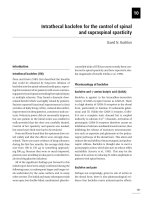Lecture Math for the pharmacy technician Concepts and calculations Chapter 6 – Lynn M. Egler, Kathryn A. Booth
Bạn đang xem bản rút gọn của tài liệu. Xem và tải ngay bản đầy đủ của tài liệu tại đây (1.57 MB, 44 trang )
Math for the Pharmacy Technician:
Concepts and Calculations
Egler • Booth
Chapter 6: Dosage Calculations
McGraw-Hill
©2010 by the McGraw-Hill Companies, Inc All Rights Reserved
6-2
METHODS OF DOSAGE
CALCULATIONS
McGraw-Hill
©2010 by the McGraw-Hill Companies, Inc All Rights Reserved
6-3
Learning Objectives
When you have successfully completed Chapter 6, you will
have mastered skills to be able to:
Identify the information on a
medication order and drug label
needed to calculate the desired
dose.
Convert the dosage ordered to the desired dose.
McGraw-Hill
©2010 by the McGraw-Hill Companies, Inc All Rights Reserved
6-4
Learning Objectives (con’t)
Calculate the amount to dispense of
a drug.
Recognize common errors that
occur during dose calculations.
Calculate estimated days supply.
McGraw-Hill
©2010 by the McGraw-Hill Companies, Inc All Rights Reserved
6-5
Introduction
This chapter will bring all of the previous information
together to calculate the amount of medication to
dispense to a patient.
You will use:
Basic math
Information from the physician’s order
Drug labels
Method of converting quantities from one unit
of measurement to another
McGraw-Hill
©2010 by the McGraw-Hill Companies, Inc All Rights Reserved
6-6
Dosages and Doses
To calculate medication dosages you must know:
Desired Dose:
The amount of the drug to be dispensed at a single time.
Its unit of measurement must be the same as the dosage
unit.
McGraw-Hill
©2010 by the McGraw-Hill Companies, Inc All Rights Reserved
6-7
Dosages and Doses (con’t)
Dosage ordered:
The total amount of drug the physician has ordered,
along with the frequency.
Its unit of measurement may not be the same as that of
the dosage unit.
McGraw-Hill
©2010 by the McGraw-Hill Companies, Inc All Rights Reserved
6-8
Dosages and Doses (con’t)
Dose on hand:
The amount of drug contained within a dosage unit
of medication.
If a medication has 250 mg of drug per
tablet, the dose on hand is 250 mg.
McGraw-Hill
©2010 by the McGraw-Hill Companies, Inc All Rights Reserved
6-9
Dosages and Doses (con’t)
The unit of measurement for the desired dose
must be the same as the unit of measurement
of the dose on hand before the amount to
dispensed can be calculated.
This is calculated by converting the dose
ordered into the same unit of measurement as
the dose on hand; once converted it becomes
the desired dose.
McGraw-Hill
©2010 by the McGraw-Hill Companies, Inc All Rights Reserved
6-10
Calculating the Desired Dose
Before calculating the amount to be
dispensed, you must first determine the
desired dose.
The dosage ordered is not always written in
the same units that are found on the drug
label.
You must convert the dosage ordered into a
desired dose having the same units as the
dose on hand.
McGraw-Hill
©2010 by the McGraw-Hill Companies, Inc All Rights Reserved
6-11
Calculating the Desired Dose
(con’t)
Three methods to calculate desired dose:
Fraction proportion
Ratio proportion
Dimensional analysis
Each gives the same result
Use the method that you like
Once you identify your favorite method,
follow the color coding of that method in the
book
McGraw-Hill
©2010 by the McGraw-Hill Companies, Inc All Rights Reserved
6-12
Fraction Proportion Method
Procedure Checklist 6-1
1.
Write the conversion factor with the units
that you are converting to in the numerator
and the units you are converting from in the
denominator.
2.
Write a fraction with the unknown,”?,” in the
numerator and the number that you need to
convert in the denominator.
McGraw-Hill
©2010 by the McGraw-Hill Companies, Inc All Rights Reserved
Fraction Proportion Method
6-13
(con’t)
3. Set the two fractions up as a proportion.
4. Cancel units.
5. Cross multiply, then solve for the unknown
value.
Example:
The dosage ordered is 0.2 mg once a day.
The dosage strength is 100 mcg/tablet.
Find the desired dose.
Desired Dose = 200 mcg
McGraw-Hill
©2010 by the McGraw-Hill Companies, Inc All Rights Reserved
6-14
CAUTION!
In a fraction proportion, units from the
fraction can be canceled only when they
are the same portion of the fraction.
Units in the denominator of one fraction
cannot be canceled with units found in
the numerator of the other.
Always include the units when performing
calculations.
McGraw-Hill
©2010 by the McGraw-Hill Companies, Inc All Rights Reserved
6-15
Ratio Proportion Method
Procedure Checklist 6-2
1.
Write the conversion factor as a ratio A : B
so that A has the units of the value that you
are converting (the dosage ordered) and B
has the unit of value of the dose on hand.
2.
Write a second C : D so that C is the
missing value (desired dose) and D is the
number that is being converted (the dosage
ordered).
McGraw-Hill
©2010 by the McGraw-Hill Companies, Inc All Rights Reserved
6-16
Ratio Proportion Method (con’t)
3. Write the proportion in the form A : B :: C : D.
Note: When using the ratio proportion method
to calculate the desired dose, C indicates the
unknown value (desired dose).
4. Cancel units.
5. Solve the proportion by multiplying means
and extremes.
McGraw-Hill
©2010 by the McGraw-Hill Companies, Inc All Rights Reserved
6-17
Ratio Proportion Method (con’t)
Example
Practice by determining the desired dose.
The order reads: ASA gr v PO daily.
The drug label indicates 325 mg tablets.
Find the desired dose.
The desired dose is 325 mg.
McGraw-Hill
©2010 by the McGraw-Hill Companies, Inc All Rights Reserved
6-18
CAUTION!
In a ratio proportion, units can be
canceled only when they are found
in the same part of each of the
ratios.
Always include the units when
performing calculations.
McGraw-Hill
©2010 by the McGraw-Hill Companies, Inc All Rights Reserved
6-19
Dimensional Analysis
Procedure Checklist 6-3
1.
2.
Determine the units of measure for the
answer and place it as the unknown on one
side of the equation.
On the other side of the equation, write a
conversion factor with the units of measure
for the answer on top and the units you are
converting from on the bottom.
McGraw-Hill
©2010 by the McGraw-Hill Companies, Inc All Rights Reserved
6-20
Dimensional Analysis (con’t)
3. Multiply the conversion factor by the number
that is being converted over one.
4. Cancel units on the right side of the equation.
The remaining unit of measure on the right
side of the equation should match the
unknown unit of measure on the left side of
the equation.
5. Solve the equation.
McGraw-Hill
©2010 by the McGraw-Hill Companies, Inc All Rights Reserved
6-21
Dimensional Analysis (con’t)
Example
Find the desired dose for the following:
Ordered: Levsinex timecaps ER 1500 mcg once
daily
On hand: Levsinex timecaps 0.375 mg
Desired dose = 1.5 mg
McGraw-Hill
©2010 by the McGraw-Hill Companies, Inc All Rights Reserved
6-22
CAUTION!
In dimensional analysis, units can be
canceled only when they are found in
both the numerator and the
denominator of the fraction.
Always include the units when
performing calculations.
McGraw-Hill
©2010 by the McGraw-Hill Companies, Inc All Rights Reserved
6-23
Review and Practice
Determine the desired dose.
Ordered: Penicillin VK 0.25 g
On hand: Penicillin VK 500 mg
Desired dose: 250 mg
McGraw-Hill
©2010 by the McGraw-Hill Companies, Inc All Rights Reserved
Calculating the Amount to
Dispense
Once you have determined the
desired dose, you still must
calculate the amount to
dispense.
McGraw-Hill
©2010 by the McGraw-Hill Companies, Inc All Rights Reserved
6-24
6-25
Calculating the Amount to
Dispense (con’t)
To calculate the amount of medication to dispense (A), the
following information must be known:
The desired dose (D) or the amount of drug to
be given at a single time.
This is the dosage ordered converted to the
same units as the dose on hand, if
necessary.
McGraw-Hill
©2010 by the McGraw-Hill Companies, Inc All Rights Reserved









